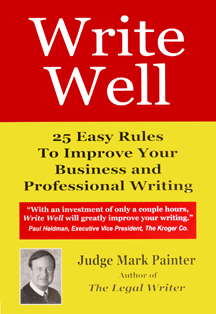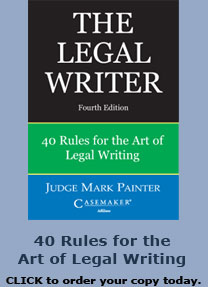|
In the previous 50 columns (which originally ran in Ohio Lawyers Weekly), I have preached the gospel of Plain English. What exactly is Plain English, and how does it translate to legal writing? This will be new to new readers, a recap for some.
The Plain English movement is simply this: write in the most readable manner for your audience to understand. That doesn’t sound difficult, but as lawyers, we have fallen into bad habits, many of which are hard to break. At minimum, though, you can improve your writing by making some elementary changes:
Shorter sentence length. Sentence length is the first major element of readability. Sentences should average no more than 18 words, and never go over 35. One exception to the 35-word limit: lists.
-
Fewer passive sentences. Active voice is another element of readability. We talk in the active voice. Sometimes passive is unavoidable, but usually not. Write the court reversed the judgment, rather than the judgment was reversed.
-
Fewer verbs turned into nouns. Question words ending in -tion or –ment. Some simply cover up perfectly good verbs. How about “Smith Company determined, rather than “made a determination?” “The plan improved the roadway,” rather than “resulted in an improvement?” Or you “moved for summary judgment,” not “filed a motion?” Putting nominalizations back into verbs greatly improves your writing, saving not only words, but also awkward constructions.
-
Shorter paragraphs. We tend to run on and on. There is no specific rule, but don’t ever go more than a half page – the reader has to see when it’s safe to take a break.
-
More headings. Headings are signposts for the reader. And we should use them for the same reason as writing shorter sentences and shorter paragraphs, with the additional benefit of imparting information. Instead of Facts or Argument write The Fire and the Aftermath or No Miranda Violation.
-
Easily readable typefaces. Stop using Times New Roman. It was designed for newsprint, where the ink expands. But our laser printers print the periods and commas too small. Never use Courier – it’s the most unreadable typeface. Use Georgia or Palatino – those are the best that everyone has on their PC. Use Arial or Verdana for headings, but not text.
-
One word, not three. The goofy couplets, null and void, fit and proper, will and testament, sell and convey, due and payable, haven’t been necessary for almost a thousand years, but we forgot to change.
-
Purge lawspeak. Hereinafter, Aforesaid, Thereinafter, Whereas, and the like are banned, unless you are trying to be funny. And kill the parenthetical numericals, as in one (1). They can only get you in trouble. If the numbers and letters conflict, the words control – but the numbers are more likely to be right!
These are just a few quick ways to make your writing better. You can find a more in-depth discussion of all the above, plus more, in The Legal Writer: 40 Rules for the Art of Legal Writing.
Readability
I always show the readability scores for the column. Statistics for this column (excepting the quotes, of course, which are unintelligible): 11 words per sentence, 3 percent passive voice, and grade level 8.8.
____________________________________
Mark Painter has served as a judge on the Ohio First District Court of Appeals for 12 years, after 13 years on the Hamilton County Municipal Court. He has taught as an Adjunct Professor at the University of Cincinnati College of Law since 1990. Judge Painter has given dozens of seminars on legal writing. Contact him through his website, www.judgepainter.org
|








